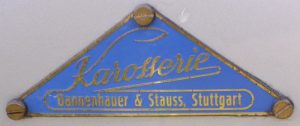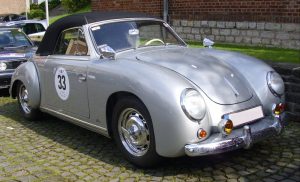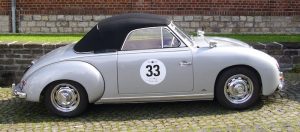DANNENHAUER & STAUSS’ BEAUTIFUL SPORT-KABRIOLET
Steve Hole tells the story of the glorious DANNENHAUER & STAUSS SPORT-KABRIOLET their take on the Porsche 356 theme
This Stuttgart-based company was run by Gottfried Dannenhauser, a VW Beetle specialist and his son-in-law Kurt Stauss, a skilled panel-beater. They had worked with well-known Stuttgart-based coachworks Stuttgarter Karosseriewerk Reutter pre-war on the KdF Wagen.
Reutter is also a very interesting company founded in 1906 by Wilhelm Reutter and soon joined by his brother Albert. For many years they built bodies for Porsche, culminating with the 356 from 1949.
By 1954 they had built 5000 356 bodies. Most interestingly they also indirectly founded Recaro after creating a patented type of seat for Porsche. The manufacturer bought the company in 1963 and formed the name ‘Recaro’ from REutter CAROsserie and their concentration focused on the production of seats thereafter but not just any old seats!
Back to Dannenhauer and Stauss’s beautiful creation and in 1950, a couple of engineer/designer Dr Wunibald Kamm’s (Kamm tail) students – Messrs Oswald and Wagner – designed a restyled body for the 356, which was ready by the end of the year. They called it the Sport-Kabriolett. It had an aluminium body with pressed steel doors. Originally, the car was fitted with a Beetle-spec air-cooled engine although most were retrospectively had a Porsche 356 ‘Fuhrmann’ unit transplanted.
They used a variety of Beetle and Porche 356 parts and interestingly Dannenhauer and Stauss are regarded as being a Volkswagen coachbuilder rather than a Porsche one such as Reutter. They had to buy their own ‘donors’ from dealers’ showrooms even sourcing them from as far away as Sweden, as Porsche and Volkswagen wouldn’t offer them trade terms.
Dannenhaur & Stauss worked with several other manufacturers over the years including DKW, for whom they built Monza bodies.
They sold Sport Kabriolets until 1957 although the arrival of the mass-produced Karmann Ghia in 1955 had pretty much done for their car in sales terms. Exact production numbers aren’t really known although estimates suggest that 130 cabriolets and 5 coupés may have been produced.
The company moved away from coachbuilt bodies after the Sport-Kabriolet concentrating on car restoration work.
Images by Buch-t – Own work, GFDL, https://commons.wikimedia.org/w/index.php?curid=16822660
| Print article | This entry was posted by admin on December 22, 2023 at 3:14 pm, and is filed under Uncategorized. Follow any responses to this post through RSS 2.0. Both comments and pings are currently closed. |
Comments are closed.























